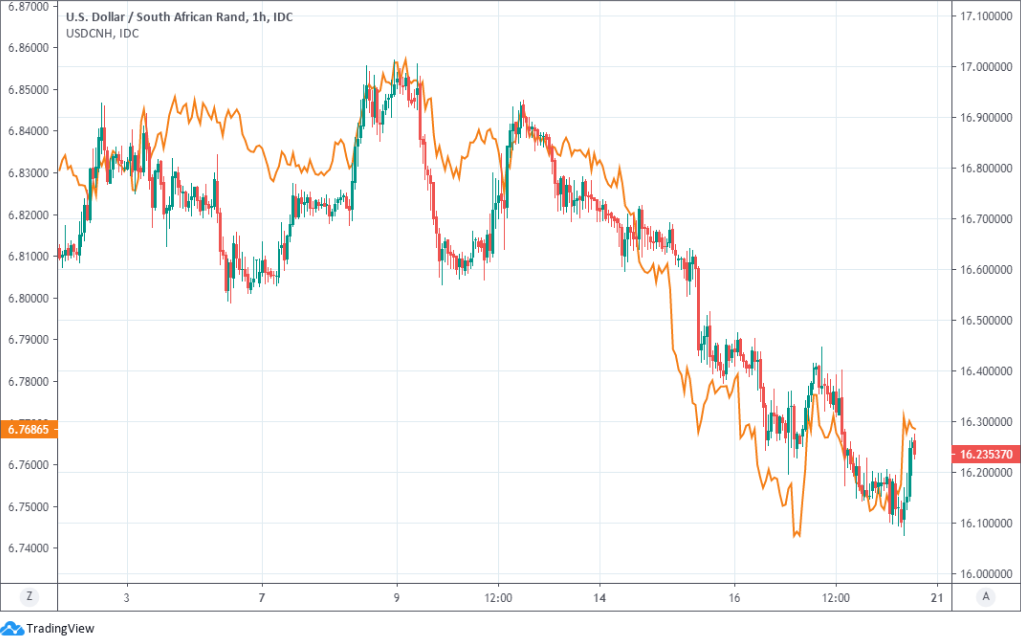South African Rand Rally Interrupted by USD/CNH Bump in Reminder of U.S. Election Stakes
- Written by: James Skinner
-

Image © Adobe Images
- GBP/ZAR spot rate at time of writing: 21.03
- Bank transfer rate (indicative guide): 20.26-20.41
- FX specialist providers (indicative guide): 20.68-20.81
- More information on FX specialist rates here
The Rand snapped a five-day winning streak Friday after the Department of Commerce pulled the rug out from under the feet of two social media firms and in the process, the Chinese Yuan, causing risk currencies to falter and reminding investors of the stakes at play in the looming U.S. presidential election.
Commerce Department officials said that of September 20, 2020 the distribution and/or maintenance of WeChat and TikTok applications will be banned in accordance with an August 06 order from President Donald Trump.
Provision of other services to or from either will also be banned in moves intended to force each company’s U.S. operations out of Chinese hands, or out of the country “to protect the national security” of the U.S.
Confirmation of the bans prompted USD/CNH to recover from earlier losses before lifting it to a second consecutive day of gains, which further interrupted what had been a six-week long party in emerging market exchange rates that favoured those involving China-exposed currencies.
“What is interesting about CNH specifically is that, on a trade-weighted basis, it has been rallying fairly consistently since bottoming out near multi-year lows at the end of July,” says Shahab Jalinoos, head of FX strategy at Credit Suisse. “The broader implication is a feedback mechanism that allows, at least in theory, for greater comfort on local currency strength vs USD in any country that has a large CNH component in its trade-weighted basket.”
Friday's price action came with the domestic focus on government assurances to administrators of the embattled South African Airways that more public cash is on the way, although there was little obvious impact on the bond market, and days after President Cyril Ramaphosa set out plans for a further easing of coronavirus-related restrictions with a looming move down to Alert Level 1.

Above: USD/ZAR rate shown at 15-minute intervals alongside USD/CNH offshore Yuan exchange rate (orange line, left axis).
The Yuan has rallied since late July, putting pressure on the Dollar while lifting emerging market boats at the same time.
It’s not clear what triggered the rally but USD/CNH reached its lowest since May 2019 and the last significant escalation of the trade war earlier this week, after being aided by better-than-expected industrial production numbers and a first increase in Chinese retail sales for 2020.
“Global determinants are still at play, exaggerating the effect of local influences on the rand while watering them down on yields,” says Nema Ramkhelawan-Bhana, an economist at Rand Merchant Bank. “The US dollar’s retreat bodes well for the local unit, which has breached its 200-day moving average of 16.58, while the snapping up of US treasuries post the Fed meeting limits the downside on domestic bond yields. The rand has gapped sharply over the last week, outperforming its EM peers. USD/ZAR16.00 (last traded in mid-March) is now firmly in sight, but the currency pair is still well off its pre-covid levels.”
China’s rally had brought USD/ZAR down to its lowest since late March and stoked expectations of further gains to come, especially after the South African Reserve Bank eschewed an interest rate cut on Thursday, although this outlook might now be in doubt following Friday’s move from the Commerce Department.
“Beyond the possibility of China reflation, the strong rebound in ZAR, MXN and BRL during September is also being driven by relative FX implied yield attraction,” says Athanasios Vamvakidis, head of FX strategy at BofA Global Research. “With respect to MXN and ZAR, we are long USD, taking the view that the long positions in MXN and ZAR (bonds too) are vulnerable to risk off, especially as the November 3rd US election approaches.”
Above: USD/ZAR rate shown at daily intervals alongside USD/CNH offshore Yuan exchange rate (orange line, left axis).
Bans on Chinese social media firms demonstrate that mistrust and hostility still bubble away beneath the surface in Washington at least, and could foretell what’s to come for the Yuan and other emerging market currencies in the event of a surprise election win by President Donald Trump on November 03.
“The biggest tail-risk to the USD liquidity driven reflation-put is a new Trump victory, since his policy mix has been harmful for the other source of global USD liquidity – namely world trade,” says Andreas Steno Larsen, chief FX strategist at Nordea Markets. “Trumps tariff war once again strengthened the USD alongside weaker trade flows. World trade is very likely to rebound in to 2021 unless Trump restarts a trade war with China during his potential second-term. This also implies that a Biden victory should lead to a markedly weaker USD. The biggest recipient of flows when world trade rebounds swiftly is Emerging Markets, while the USD is clearly the weak spot. Countries like Brazil, India and South Africa are three clear examples.”
The rally has so-far erased one half of the U.S. trade tariffs from history but those levies still remain in place on Chinese goods while Trump has hinted numerous times of a desire for a complete “decoupling” from the world’s second largest economy. There might be little left to persuade him against that course of action in any second term given the incumbent will then be a 'lame duck' President who's unable to occupy the White House for a third time.
The Dollar has been sold heavily of late for a number of reasons including Trump’s flagging position in opinion polls, but few if any of those gave him any prospect of success in 2016, which could come into sharp focus among investors in the weeks leading up to the November 03 election.
This alone could prompt October weakness in the Rand but in the absence of that the downside following any Trump victory might then be magnified.
Above: Pound-to-Rand rate at daily intervals with 200-day moving-average (black) and USD/ZAR (orange line, left axis).
